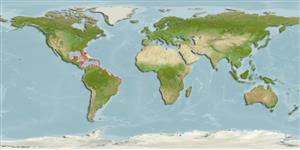Common names from other countries
Environment: milieu / climate zone / depth range / distribution range
Ecologia
marino associati a barriera corallina; distribuzione batimetrica 0 - 12 m (Ref. 9710). Subtropical; 43°N - 37°S
Western Atlantic: Massachusetts (USA), Bermuda, and the Gulf of Mexico to Argentina.
Size / Peso / Age
Maturity: Lm ? range ? - ? cm
Max length : 50.0 cm TL maschio/sesso non determinato; (Ref. 7251); common length : 35.0 cm TL maschio/sesso non determinato; (Ref. 5217); peso massimo pubblicato: 560.00 g (Ref. 40637)
Spine dorsali (totale): 7 - 8; Raggi dorsali molli (totale): 19-20; Spine anali 2-3; Raggi anali molli: 16 - 18. Dorsal and anal fins have very long, dark anterior lobes (Ref. 26938). Bluish silver on back, shading to silver on sides, with four narrow dark bars on upper of body (Ref. 13442).
Adults form schools in clear coastal areas, usually near coral formations (Ref. 5217). Juveniles common in clean sandy beaches (Ref. 5217). Adults feed on crustaceans, polychaete worms, insect pupae, mollusks and fishes (Ref. 9626). Between 1995 and 2000, at least 2 specimens were traded as aquarium fish at Fortaleza, Ceará (Ref. 49392).
Life cycle and mating behavior
Maturità | Riproduzione | Deposizione | Uova | Fecundity | Larve
Robins, C.R. and G.C. Ray, 1986. A field guide to Atlantic coast fishes of North America. Houghton Mifflin Company, Boston, U.S.A. 354 p. (Ref. 7251)
IUCN Red List Status (Ref. 130435)
CITES (Ref. 128078)
Not Evaluated
Threat to humans
Reports of ciguatera poisoning (Ref. 30911)
Human uses
Pesca: scarso interesse commerciale; Acquacoltura: commerciale; Pesce da pesca sportiva: si
Informazioni ulteriori
BibliografiaAcquacolturaProfilo di acquacolturaVarietàGeneticaElectrophoresesEreditarietàMalattieElaborazioneMass conversion
Strumenti
Special reports
Download XML
Fonti Internet
Estimates based on models
Preferred temperature (Ref.
115969): 23.2 - 28.1, mean 27.3 (based on 851 cells).
Phylogenetic diversity index (Ref.
82804): PD
50 = 0.5000 [Uniqueness, from 0.5 = low to 2.0 = high].
Bayesian length-weight: a=0.01622 (0.00839 - 0.03134), b=2.83 (2.66 - 3.00), in cm Total Length, based on LWR estimates for this species & Genus-body shape (Ref.
93245).
Trophic level (Ref.
69278): 4.3 ±0.4 se; based on diet studies.
Resilienza (Ref.
120179): Medio, tempo minimo di raddoppiamento della popolazione 1.4 - 4.4 anni (Assuming tm=2-4).
Fishing Vulnerability (Ref.
59153): Moderate vulnerability (40 of 100).
